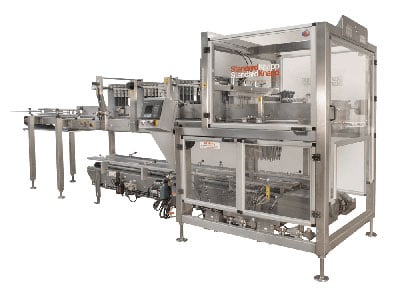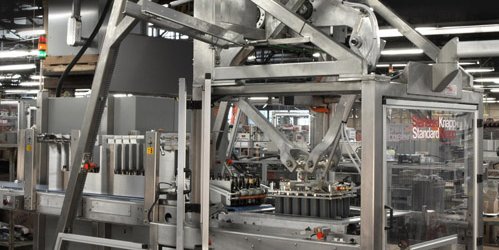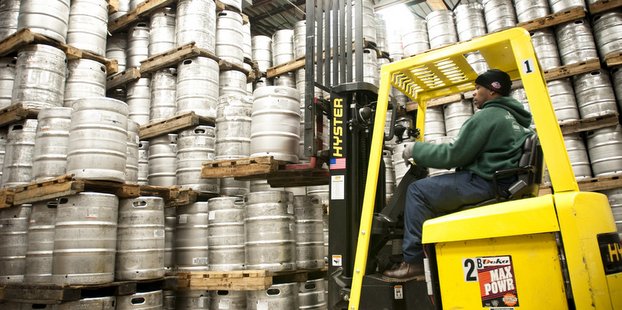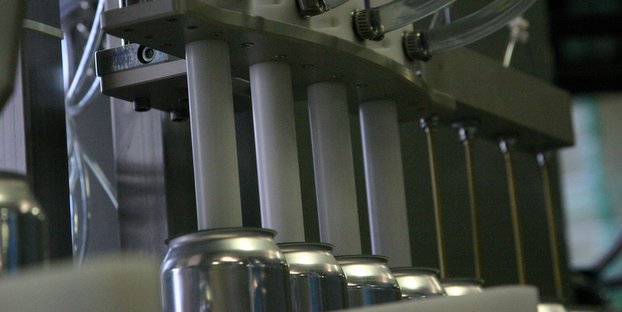
“A lotta ins, a lotta outs, a lotta what-have-yous.” — Jeffrey Lebowski
The above quote is from the seminal, timeless work of modern fiction, The Big Lebowski. Lebowski was discussing his own messy situation, but he might as well have been describing the brewing business workflow. Shipments of ingredients and packaging materials arrive; loads of packaged brewed product are sent out the door. It’s a delicate machine of ins and outs, and as craft brewers start to sell more product and expand into new territories, it all leads to more ins, more outs and tons of logistical what-have-yous.
Hey, careful man, there’s a beverage here
“During a routine walk-through, I noticed a minor issue with cardboard tearing on the flaps of a master carton. It was determined that we were not making a clean cut on the slitter/sealer,” said Kris Scholl, the technical director at Deschutes Brewery. “It was found that the cutting blade was not properly positioned. The line was stopped, the blade was adjusted and the line was restarted and the problem was resolved. Or was it?”

“How can we be sure the problem doesn’t re-occur?” Scholl continued. “Was the machine properly set up in the first place? Was there a standard operating procedure that detailed exactly what the setup should have been? Are employees properly trained to recognize the problem in the first place? Is there a process to review all incidents as they occur to be sure we eliminate them in the future? It is much easier to make minor adjustments on the fly and keep going without ever recognizing or understanding the root cause or underlying issue.”
Scholl arrived at Deschutes in January, bringing 16 years of experience working at Anheuser-Busch Inbev where he gained operations expertise, designed process improvement initiatives, led cross-functional teams, planned strategies and managed projects. He said that over time, all of these seemingly small items can add up to big efficiency hits.
“Focusing on root cause is a mindset that is very difficult to make part of the culture, but really can make big improvements once it is part of the DNA of the operation,” he said. “The best operations have figured this out and have a well-developed process in place to ensure continuous improvement.”
At least it’s an ethos
Steve Hunter, owner of Facility Planning, is a long-time beverage space planner but is new to the craft brewing world. As he and his team have started to look at the specific challenges of the craft brewer, his specific advice can all be boiled down into tenets of preparedness and planning.
For example, unlike the big guys, craft brewers aren’t just pounding out massive quantities of product and not turning back. Sure, as the industry grows, certain players are doubling and tripling output, nearing the six- or seven-figure barrel output, but the ethos of craft beer is artistry and experimentation. Moves to scale up operations need to maintain that ethos.
“These guys aren’t making one beer. They are making a dozen or 20 different kinds and each has a grain build and different hops. When are these coming in the warehouse? How long can they sit on the floor? Do you get palettes at a time? Trucks at a time? How much do you have to store, and how much does it differ from your input to output?” Hunter said.
Scholl is a believer in 5S organization, the Japanese concept for housekeeping: Sort, straighten, shine, standardize and sustain. When raw materials are properly labeled and staged in an efficient and strategic manner, you are less likely to make mistakes and can save valuable time.
“These efficiency gains can add up and they do not cost much to implement, especially when they are part of the design stages of a new operation,” Scholl said.
Your revolution is over; the bums lost
So you have a well thought out design and all of the top-of-the-line equipment: Now who is going to make all of this work? Scholl routinely looks at labor efficiency in terms of hours/bbl. It is difficult to give a rule of thumb on that number across all brewer types, but the larger the batch size or the more automated the equipment, the better the efficiency should be.
“This is where scale is really an advantage,” Scholl said. “With a lot of expansion of capacity in the system it definitely pays off to look at packaging line configurations. You can minimize the number of people necessary to run a line by having operators situated to run multiple pieces of equipment that are placed in close proximity to each other. This is easier to do with a greenfield site versus trying to fit a line into an existing space.”
Scholl brings it all back to the cultural DNA of the brewery. Today’s growing craft brewers can implement some of the large-scale efficiency of an AB Inbev by thinking about principles of lean manufacturing and six-sigma quality systems that improve quality, consistency and employee engagement.
“You do not have to be big to take on such an initiative,” he said. “In fact, it is much easier to establish when your company is small and beginning to grow. The key is in building the right mindset and culture, which is easier to establish and gain buy-in when the company is starting up and finding its identity. Investing in your quality and management systems upfront will pay dividends in the future.”
There are many different packaging/shipping configurations at breweries and each brewery has its own unique challenges. Scholl says the operations with the best performance also have very well-developed and defined management systems and practices that focus on continuous improvement. He highlighted the following areas for struggling operations to find the most opportunity to improve and develop:
1. Definition of short and long term goals and objectives — What are you trying to achieve and why?
2. Appropriate skill level for the job and a comprehensive training and development strategy.
3. Comprehensive maintenance plan — predictive and preventative versus purely reactionary.
4. Lack of root cause analysis and quality management systems.
5. Underdeveloped standard procedures for setups, changeovers and overall operations.

New machinery has come to light!
Specifically on the packaging machinery side — the outs — there are plenty of options now available for myriad brewery sizes. Mario Mazzotta, customer service manager, field engineering at Standard-Knapp, said many of the craft brewers he’s spoken to are in need of an entry-level case packer in order to begin automating their packaging as they start to expand their operation and volume.
“We also learned that many of these breweries were looking to package their product into six and 12 packs that would differentiate them from the competition,” Mazzotta said. “Many were packing directly into four- and six-pack full boxes with no partitions.”
In response to this need, Standard-Knapp created the 939EZ Versatron as an entry level solution for growing craft breweries at a lower price point. There is also the 939S Versatron with the Pic-N-Place module to handle the task of packing directly into six-pack boxes with no partitions while still protecting each bottle — another one of the big questions from the craft brewing community.
S Versatron with Pic-N-Place module can efficiently place your product into partitionless cases with virtually no breakage or mis-packs. In terms of total cost of ownership, Standard-Knapp’s Versatron casepackers are built to run 24 hours a day, seven days a week with many lasting more than 30 years. These casepackers are easy to operate, highly efficient and simple to maintain. These machines also have a Human Machine Interface (HMI) that brewers can use to recover from any machine fault quickly, leading to a low mean time to recovery (MTR) and 98 percent efficiency.
Scholl agreed that moves to this type of automation are the key: “Not only does it help with efficiencies and product quality and consistency, but it allows for more advanced data analysis capabilities. With better data comes better root cause analysis which can have great returns to the business if properly taken advantage of. This is all part of a comprehensive continuous improvement program,” he said.





[…] Craft Brewing Operations […]